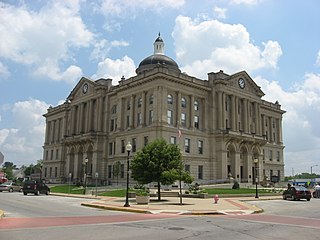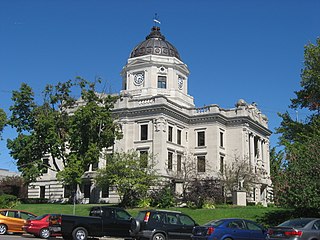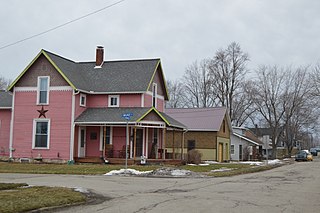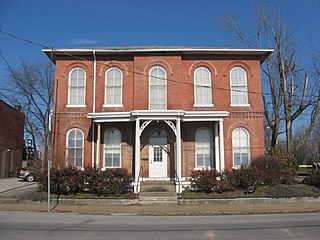
Boonville is a city in Boon Township, Warrick County, Indiana, United States. The population was 6,246 at the 2010 census. The city is the county seat of Warrick County.

The Scottsburg Courthouse Square Historic District is a national historic district located at Scottsburg, Scott County, Indiana. The district encompasses 48 contributing buildings and 8 contributing objects in the central business district of Scottsburg centered on the Scott County Courthouse. It developed between about 1873 and 1952, and includes notable examples of Italianate, Romanesque Revival, Gothic Revival, and Stick Style / Eastlake movement style architecture. The courthouse was built in 1873-1874 after the decision was made to finally locate the county seat of Scott County into a central location within the county, which caused the founding of Scottsburg. Located in the district is the separately listed Scottsburg Depot. Other notable contributing resources include the Town Tavern (1924), A&P Grocery (1923), Corner Drugstore, Harmon Building (1907), City Hall (1899-1900), Napper's Hospital (1936), Scott Theatre (1946), Scott County Public (Carnegie) Library (1919), Scott County Bank (1906), Prosser's Hardware (1912), and a statue of William Hayden English (1908).

The Corydon Historic District is a national historic district located in Corydon, Indiana, United States. The town of Corydon is also known as Indiana's First State Capital and as Historic Corydon. The district was added to the National Register of Historic Places in 1973, but the listing was amended in 1988 to expand the district's geographical boundaries and include additional sites. The district includes numerous historical structures, most notably the Old Capitol, the Old Treasury Building, Governor Hendricks' Headquarters, the Constitution Elm Memorial, the Posey House, the Kintner-McGrain House, and The Kintner House Inn, as well as other residential and commercial sites.

Downtown Nappanee Historic District is a national historic district located at Nappanee, Elkhart County, Indiana. The district encompasses 26 contributing buildings in the central business district of Nappanee. It was developed between about 1874 and 1939, and includes notable examples of Italianate and Classical Revival style architecture. Notable buildings include the Bechtel Building (1888), U.S. Post Office, Dietrich Block, Kaufman's Department Store (1902), First National Bank, Yoder's Garage, B&O Depot, Hartman Brothers Building, and Farmers and Traders Bank (1915).

Fairmount Commercial Historic District is a national historic district located at Fairmount, Grant County, Indiana. It encompasses 31 contributing buildings in the central business district of Fairmount. It developed between about 1884 and 1945, and includes notable examples of Italianate and Romanesque Revival style architecture. Notable buildings include the Scott Opera House (1884), M.A. Hiatt Building (1900), Bogue Block (1889), J.W. Dale Block (1889), Fairmount Block (1901), Fairmount Public Library (1891-1893), Odd Fellow Block (1902), and Masonic Temple (1904).

Greenfield Courthouse Square Historic District is a national historic district located at Greenfield, Hancock County, Indiana, United States. The district encompasses 72 contributing buildings and 1 contributing object in the central business district of Greenfield that developed between about 1835 and 1935. The focal point of the district is the Romanesque Revival style Hancock County Courthouse (1896–1897) and Second Empire style jail. Other notable buildings are the Riley School, A.J. Banks Building / Morgan Building (1869), Randall Block, Christian Church (1895), Bradley Methodist Church (1902), First Presbyterian Church (1906–1907), Carnegie Library (1908–1909), Andrew Jackson Banks House, D.H. Goble House, and Walpole House.

Danville Main Street Historic District is a national historic district located at Danville, Hendricks County, Indiana. The district encompasses 42 contributing buildings and 2 contributing structures in the central business district of Danville. The district developed between about 1865 and 1960 and includes notable examples of Italianate, Classical Revival, Beaux-Arts, and Tudor Revival style architecture. Located in the district is the separately liste Hendricks County Jail and Sheriff's Residence. Other notable buildings include the Hall Block, Danville Public Library (1902-1903), Hendricks County Courthouse (1915), and Danville Post Office (1936).

The New Castle Commercial Historic District is a national historic district located at New Castle, Henry County, Indiana. It encompasses 64 contributing buildings in the central business district of New Castle. It developed between about the 1849 and 1941, and includes many excellent examples of Italianate, Classical Revival, and Commercial styles of architecture. Notable sites of interest include the separately listed Henry County Courthouse. Other notable buildings include the L.A. Jennings Building (1877), Odd Fellows Hall, Murphey Building, Knights of Pythias Building (1891), Masonic Temple (1892), Bradway Building (1902), former United Brethren Church, Citizens State Bank Building (1923), S.P. Jennings and Sons Handle Factory complex, and Coca-Cola Bottling Building.

Huntington Courthouse Square Historic District is a national historic district located at Huntington, Huntington County, Indiana. The district includes 102 contributing buildings and 3 contributing structures in the central business district of Huntington. It developed between about 1845 and 1942 and includes notable examples of Italianate, Queen Anne style architecture in the United States, Romanesque Revival, Neoclassical, and Commercial style architecture. Located in the district are the separately listed Moore/Carlew Building and Hotel LaFontaine. Other notable buildings include the Hotel Huntington (1848), Opera House (1881), Lewis Block, Huntington County Courthouse (1904), old Post Office (1916), Citizens' State Bank, City Hall / Fire Station (1904), Huntington Light and Fuel Building, Our Sunday Visitor building (1926), YMCA (1929), and Huntington Theater.

Bedford Courthouse Square Historic District is a national historic district located at Bedford, Lawrence County, Indiana. The district encompasses 64 contributing buildings, 1 contributing site, and 1 contributing object in the central business district of Bedford. It developed between about 1850 and 1945, and includes examples of Italianate, Romanesque Revival, and Neoclassical style architecture. Notable contributing resources include the Soldiers', Sailors' and Pioneers Monument (1923); Michael A. Malott House ; Moses Fell Building ; Stone City Bank Building ; Dunn Memorial Masonic Temple (1918); Lawrence County Courthouse (1930); Bedford Fire Department Building ; Citizens' Bank Building (1926); Elks Club (1916); Hamer Building ; and Bedford Municipal Garage (1937).

Courthouse Square Historic District is a national historic district located at Bloomington, Monroe County, Indiana. The district encompasses 57 contributing buildings in the central business district of Bloomington. It developed between about 1847 and 1936, and includes notable examples of Classical Revival, Beaux Arts and Italianate style architecture. Located in the district are the separately listed Bloomington City Hall, Monroe County Courthouse, Princess Theatre, and Wicks Building. Other notable buildings include the Federal Building, Masonic Temple, former Faulkner Hotel, Odd Fellows Building (1892), Allen Building (1907), First National Bank Building (1907), Knights of Pythias Building (1907), and Graham Hotel Building.

Crawfordsville Commercial Historic District is a national historic district located at Crawfordsville, Montgomery County, Indiana. The district encompasses 105 contributing buildings, 1 contributing structure, and 1 contributing object in the central business district of Crawfordsville. It developed between about 1836 and 1940, and includes notable examples of Italianate, Classical Revival, and Bungalow/American Craftsman style architecture. Located in the district are the separately listed Montgomery County Jail and Sheriff's Residence and Otto Schlemmer Building. Other notable buildings are the Montgomery County Courthouse (1876), Ben Hur Life Building (1911), Hanna-Graham Building, Elston Bank Building (1869), Masonic Temple (1902), Carnegie Library (1902), Commerce Building (1907), Municipal Building (1933), Indiana National Guard Armory (1939), and U.S. Post Office (1940).

Martinsville Commercial Historic District is a national historic district located at Martinsville, Morgan County, Indiana. The district encompasses 75 contributing buildings and 1 contributing object in the central business district of Martinsville. It developed between about 1847 and 1947, and includes notable examples of Italianate, Classical Revival, and Tudor Revival style architecture. Located in the district are the separately listed Morgan County Courthouse and Blackstone House and Martinsville Telephone Company Building. Other notable buildings are the Martinsville Public Library, Martinsville City Hall (1917), Martinsville Post Office, Pitkin Building, Barskin's Department Store (1922), Indiana Theater, Steven's House / Building, Hale Building, Interurban Station, Union Block (1866), and First Christian Church (1891) and Annex (1927).

Albion Courthouse Square Historic District is a national historic district located in Albion, Noble County, Indiana. The district encompasses 61 contributing buildings, 1 contributing site, and 2 contributing structures in the central business district and surrounding residential sections of Albion. It developed between about 1855 and 1964, and includes notable examples of Greek Revival, Gothic Revival, Italianate, Romanesque Revival, Classical Revival, and Art Deco style architecture. Located in the district are the separately listed Noble County Courthouse and Noble County Sheriff's House and Jail. Other notable buildings include the U.S. Post Office (1964), Police Booth, Albion Town Hall (1930), St. Mark's Lutheran Church (1905), United Brethren Church / Masonic Lodge, Presbyterian Church, and Clapp Block / Bank Building.

Twelve Points Historic District is a national historic district located at Terre Haute, Vigo County, Indiana. It encompasses 12 contributing buildings in a suburban commercial district of Terre Haute. It developed between about 1905 and 1954, with most built between 1890 and 1920, and includes representative examples of Commercial, Art Deco, and Classical Revival style architecture. Notable buildings include the Twelve Points State Bank (1919), People State Bank (1923), Twelve Points Hotel (1908), and Garfield Theater / Harmony Hall (1939).

LaFontaine Historic District is a national historic district located at La Fontaine, Wabash County, Indiana. It encompasses 56 contributing buildings and 4 contributing structures in the central business district and surrounding residential sections of La Fontaine. It developed between about 1848 and 1930, and includes representative examples of Gothic Revival, Italianate, Queen Anne, Romanesque Revival, Classical Revival, and Bungalow / American Craftsman style architecture.

Old Warrick County Jail is a historic jail located in Boonville, Indiana. It was built in 1877, and is a two-story, Italianate style red brick building. It consists of the hipped roof former sheriff's residence at the front with the 1+1⁄2-story jail at the rear.

Original Newburgh Historic District is a national historic district located at Newburgh, Warrick County, Indiana. It encompasses 27 contributing buildings in the central business district of Newburgh. It developed between about 1850 and 1930, and includes representative examples of Italianate, Greek Revival, and Classical Revival style architecture. Located in the district is the separately listed Old Warrick County Jail. Other notable buildings include the Evansville, Suburban, and Newburgh Railway Depot (1912); I.O.O.F. Building; Carnegie Library (1919); and Newburgh Bank.

Virginia Avenue District is a national historic district located at Indianapolis, Indiana. The district encompasses 43 contributing buildings and 1 contributing structure in the Fountain Square Commercial Areas of Indianapolis. It developed between about 1871 and 1932, and notable buildings include the Sanders (Apex) Theater (1913), Southside Wagon and Carriage Works / Saffel Chair Company, Fountain Square Theater (1928), Woessner Building, Granada Theater (1928), Southside Theater (1911), Schreiber Block (1895), Fountain Square State Bank (1922), and Fountain Bank (1902).

Horace Mann Public School No. 13 is a historic school building located at Indianapolis, Indiana. It was designed by architect Edwin May (1823–1880) and built in 1873. It is a two-story, square plan, Italianate style red brick building. It has an ashlar limestone foundation and a low hipped roof with a central gabled dormer. A boiler house was added to the property in 1918.
























